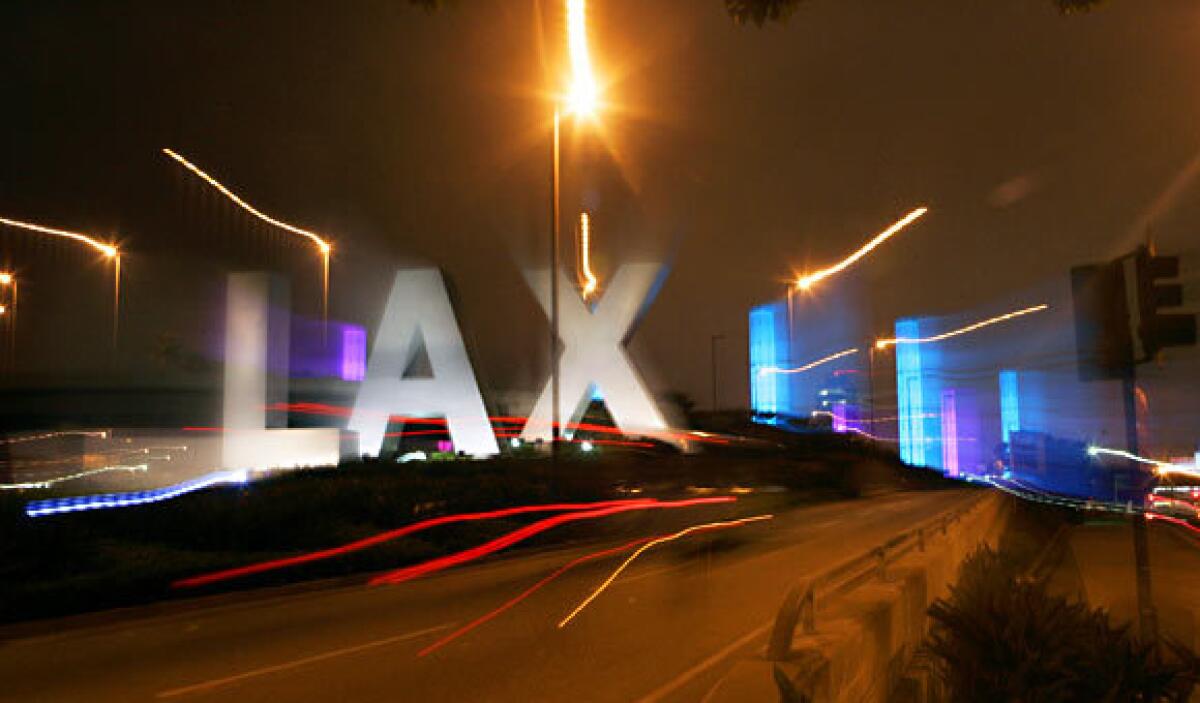25 things about LAX

- Share via
Travelers usually try to get in and get out of Los Angeles International Airport as quickly as possible. Who wouldn’t? But in their haste, here are 25 things they might have missed:
Full-body scanners were deployed late last year after it was revealed that contraband items were slipping past Transportation Security Administration screeners. LAX has 22 of the big machines, each monitored by a worker in a separate room so the revealing images remain out of view.
If a luggage scanner alarm goes off, a yellow bar on the monitor directs a TSA worker to the area in the luggage where the suspicious material is. Chocolate and cheese commonly trigger the machines, because the two foods have the same density as explosives.
Vehicle inspection checkpoints along the airport roadway open at random times according to a computer program.
Airport police recently added K9dogs that can detect what authorities call “vapor wake,” the faint whiff of chemical explosive in a bag that passed by minutes before. The dogs can then follow that scent to a suspect.
LAX police are sworn peace officers and can make arrests anywhere in California. Trainees spend six months at the LAPD academy, then face 23 weeks of field training. They also have their own shooting range at the airport.
There are always 14 firefighters on duty at LAX — never more, never less.
The four oversized fire rigs serving LAX are fitted with a Snozzle, a piece of equipment that can pierce a fuselage and pump in fire-suppressing foam.
When presidents arrive, they deplane at the West Gate, usually used for overflow flights and accessible only by car and bus.
For public health reasons, all garbage removed from international flights is incinerated.
Luggage hygiene is important too. Old tags and bar-code stickers confuse the laser readers that sort the bags along the conveyor system that takes them to the proper location for loading.
LAX is about the size of eight midmarket airports combined. By itself, Terminal 1 is about as big as Long Beach Airport. Including part-timers and contractors, 45,000 people work at LAX.
The airport is set up like two airfields: the south and the north, with two side-by-side runways on each. Only two taxiways connect the north and south, but a third is about to open.
Decades ago, engineers attempted to tunnel Lincoln Boulevard beneath the airport. The four- to six-lane project was abandoned beneath the north runways. The tunnel is still there and must be inspected periodically for structural integrity.
The Tom Bradley International Terminal expansion is one of L.A. County’s biggest construction sites. Crawling with bulldozers and construction workers, the giant dig resembles an ant farm. Its target opening: Dec. 12, 2012 — 12/12/12.
The best hangout during long stopovers is the food court in the Bradley terminal, which you can access without going through a TSA checkpoint. It has the most food choices, nicest views and most comfortable seating.
The best place to escape with your laptop: the reLAX lounge in the Bradley terminal, accessible before passing through security. Not only do you get an hour of Wi-Fi for your $15, but you also get a spacious place to unwind. It’s also a great perch for watching that ant farm.
One of the best panoramic views in town is from a window seat at Encounter Restaurant, in the UFO-shaped Theme Building. The ahi tuna tartare, with a soy glaze, might be the tastiest in town ($18).
El Segundo’s Imperial Hill area (also known as Clutter’s Park) is a plane spotter’s paradise. Another good viewing location is north of the airport, next to the In-N-Out Burger on Sepulveda Boulevard.
For photographers specializing in aircraft, LAX is said to have one of the best, most varied fleets.
A biologist helps control birds on the runways. Gulls are less of an issue than smaller, sparrow-type birds. When the birds become a danger, guns with blanks are used to drive them away. Sometimes traps are used to relocate them.
On July 4, pilots steepen their takeoffs and descents to avoid sporadic gunfire from holiday celebrants.
Terminal traffic is crushing at 7 p.m. because it’s a busy time for both arriving and departing domestic and international passengers. Morning, when domestic traffic is high, is usually a quiet time in the Bradley terminal. Likewise, when the Bradley is busy near midnight, domestic traffic has all but stopped.
The last commercial crash at LAX was two decades ago. On Feb. 1, 1991, a USAir flight landed atop an out-of-position SkyWest flight getting ready to take off, killing 34. From the tower transcript: “OK, we just had a 737 land and blow up, he went up in flame, he’s off the runway right now, two four left is closed.”
Despite the addition of self-help kiosks, elite service desks, etc., the curbside Skycap is still your best, hassle-free option for check-in and baggage drop-off. You avoid the confusing and cramped terminals, making it well worth the modest tip.
LAX firetrucks honor important events — major new flight routes, pilot retirements — with streaming water salutes reminiscent of what fireboats do in harbors.
More to Read
Sign up for The Wild
We’ll help you find the best places to hike, bike and run, as well as the perfect silent spots for meditation and yoga.
You may occasionally receive promotional content from the Los Angeles Times.







